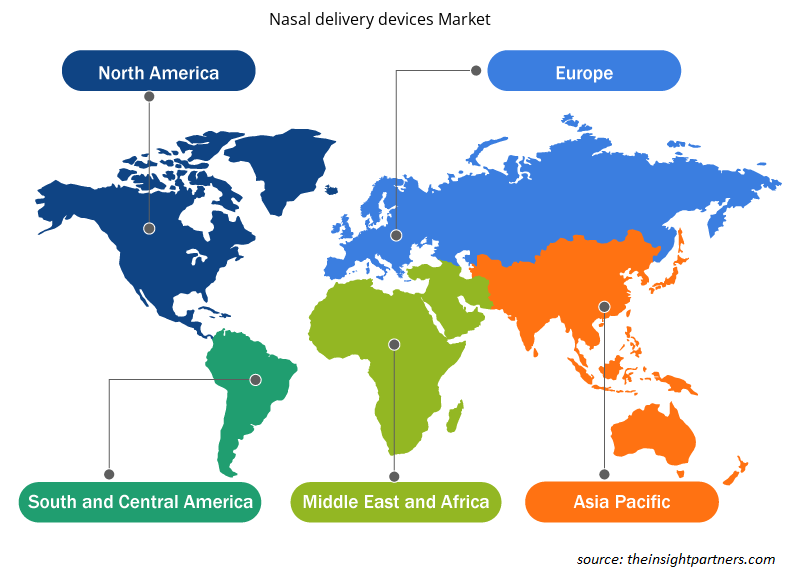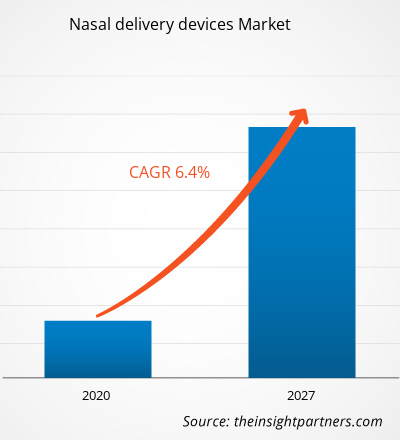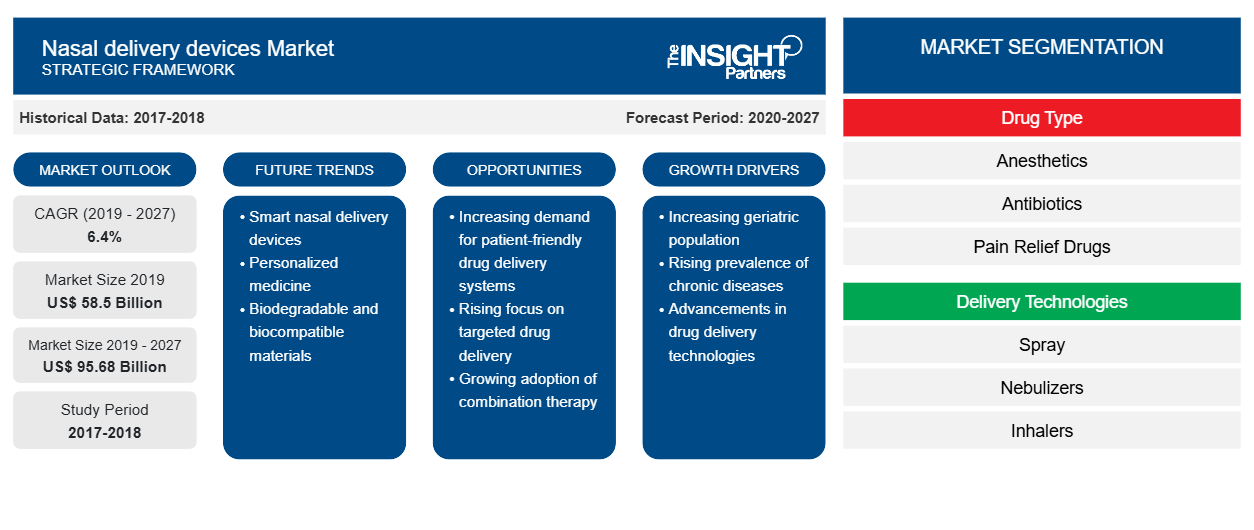Si prevede che il mercato dei dispositivi di somministrazione nasale raggiungerà i 95.676,62 milioni di dollari entro il 2027, rispetto ai 58.502,18 milioni di dollari del 2019. Si stima che il mercato crescerà con un CAGR del 6,4% dal 2020 al 2027.
La somministrazione nasale dei farmaci è una delle vie di somministrazione dei farmaci più preferite tra i pazienti e gli operatori sanitari. Ciò può essere attribuito principalmente alla natura non invasiva di questa via di somministrazione e alla maggiore assorbibilità del farmaco attraverso la via nasale. Inoltre, la via nasale offre un ambiente meno ostile per i farmaci rispetto alla via gastrointestinale, consentendo così un migliore assorbimento del farmaco. La facile somministrazione di questi farmaci svolge un ruolo cruciale nel migliorare l'aderenza alle terapie farmacologiche tra i pazienti, che a sua volta determina i risultati per i pazienti. Considerando questi fattori, la preferenza per la somministrazione nasale dei farmaci sta aumentando tra i pazienti e gli operatori sanitari. Essendo altamente vascolare, la cavità nasale migliora l'assorbimento del farmaco con conseguente azione rapida. L'Organizzazione mondiale della sanità (OMS) ha linee guida specifiche per i produttori, che delineano tutti i requisiti necessari per l'adozione di nuovi dispositivi di somministrazione nasale con un sistema di somministrazione monouso. Pertanto, la somministrazione nasale dei farmaci, a differenza di altre vie di somministrazione dei farmaci, non richiede metodi sterili rigorosi per la somministrazione dei farmaci nel corpo. Pertanto, l'elevata preferenza per la somministrazione nasale dei farmaci tra i pazienti e gli operatori sanitari, dovuta alla crescente consapevolezza dei suoi benefici, sta guidando la crescita del mercato.
Personalizza questo report in base alle tue esigenze
Riceverai la personalizzazione gratuita di qualsiasi report, comprese parti di questo report, o analisi a livello nazionale, pacchetto dati Excel, oltre a usufruire di grandi offerte e sconti per start-up e università
-
Scopri le principali tendenze di mercato in questo rapporto.Questo campione GRATUITO includerà analisi di dati che spaziano dalle tendenze di mercato alle stime e alle previsioni.
Approfondimenti di mercato
Crescente prevalenza di malattie respiratorie e del sistema nervoso centrale
Gli studi iniziali di proof-of-concept che utilizzano nuovi dispositivi di somministrazione nasale di farmaci hanno mostrato risultati promettenti nel trattamento di malattie respiratorie, disturbi neurologici e altri. I dispositivi di somministrazione di farmaci svolgono un ruolo essenziale nel garantire la somministrazione dell'intero farmaco al sito bersaglio nella cavità nasale. Negli ultimi decenni, sono stati introdotti diversi approcci innovativi di somministrazione di farmaci che potrebbero superare le sfide legate all'attraversamento della barriera emato-encefalica (BBB). Diversi studi scientifici supportano l'ipotesi che la somministrazione di farmaci attraverso la via nasale possa consentire a concentrazioni più elevate di farmaci di attraversare la BBB. La crescente incidenza di disturbi neurologici aumenterebbe la domanda di dispositivi di somministrazione nasale. Secondo l'American Society of Clinical Oncology (ASCO), nel 2020, negli Stati Uniti sono stati diagnosticati circa 3.540 tumori cerebrali e di altro tipo in bambini di età compresa tra 0 e 14 anni. Il rapporto ha anche affermato che i tumori cerebrali e di altro tipo sono i secondi tumori più comuni tra i bambini, rappresentando circa il 26% dei casi di cancro nei bambini di età inferiore ai 15 anni.
Condizioni respiratorie come infezioni acute delle basse vie respiratorie, tubercolosi, broncopneumopatia cronica ostruttiva (BPCO, uno spettro di malattie che include bronchite ed enfisema), asma e cancro ai polmoni sono tra le cause più comuni di gravi malattie e decessi a livello globale. La crescente urbanizzazione e l'inquinamento, uno stile di vita e abitudini malsane e l'elevata prevalenza del fumo di tabacco sono tra i fattori che portano all'aumento dei casi di malattie respiratorie e cardiovascolari. Le malattie respiratorie potrebbero causare insufficienza respiratoria acuta, il cui trattamento richiede la somministrazione di farmaci nasali per un supporto continuo. Secondo il Global Asthma Report 2018, pubblicato da Global Asthma Network, circa 330 milioni di persone nel mondo sono asmatiche. Inoltre, secondo le stime di Global Burden of Disease, uno speciale progetto di ricerca dell'Institute for Health Metrics and Evaluation, nel 2016 circa 420.000 persone sono morte a causa dell'asma. Secondo uno studio pubblicato nel 2018 dalla National Library of Medicine degli Stati Uniti National Institutes of Health, la prevalenza dell'asma è costantemente elevata in Corea, soprattutto tra le donne e gli anziani. Inoltre, secondo il rapporto Global Burden of Disease Study, la prevalenza dei casi di BPCO era di 251 milioni nel 2016. Oltre il 90% dei decessi per BPCO si verifica nei paesi a basso e medio reddito (LMIC) e la malattia è destinata a diventare una delle principali cause di morte nel mondo nei prossimi 15 anni.
Pertanto, la crescente prevalenza di malattie respiratorie, disturbi neurologici e altre malattie croniche sta aumentando la domanda di dispositivi di somministrazione nasale per un'efficace somministrazione del farmaco nei siti target.
Informazioni sul tipo di farmaco
In base al tipo di farmaco, il mercato dei dispositivi di somministrazione nasale è segmentato in anestetici, antibiotici, farmaci antidolorifici, integratori di calcio, vasocostrittori, antistaminici e altri. Nel 2019, il segmento degli antistaminici ha rappresentato la quota maggiore del mercato. La crescita di questo segmento è attribuita all'aumento della rinite allergica.
Approfondimenti sulle tecnologie di consegna
In base alle tecnologie di somministrazione, il mercato globale dei dispositivi di somministrazione nasale è segmentato in spray, nebulizzatori, inalatori e altri. Nel 2019, il segmento degli inalatori ha detenuto una quota importante del mercato e si prevede che registrerà il CAGR più elevato nel mercato durante il periodo di previsione.
Informazioni per l'utente finale
In base all'utente finale, il mercato globale dei dispositivi di somministrazione nasale è segmentato in contesti di assistenza domiciliare, ospedali e cliniche. Nel 2019, il segmento degli ambienti di assistenza domiciliare ha detenuto una quota importante del mercato e si prevede che registrerà il CAGR più elevato nel mercato durante il periodo di previsione.
I lanci e le approvazioni di prodotti sono le strategie comunemente adottate dalle aziende per espandere la loro presenza globale e i portafogli di prodotti per soddisfare la crescente domanda dei consumatori. Gli operatori del mercato dei dispositivi di somministrazione nasale adottano la strategia delle collaborazioni per ampliare la base clienti in tutto il mondo, il che consente loro anche di mantenere il loro marchio a livello globale.
Approfondimenti regionali sul mercato dei dispositivi di somministrazione nasale
Le tendenze regionali e i fattori che influenzano il mercato dei dispositivi di somministrazione nasale durante il periodo di previsione sono stati ampiamente spiegati dagli analisti di Insight Partners. Questa sezione discute anche i segmenti di mercato dei dispositivi di somministrazione nasale e la geografia in Nord America, Europa, Asia Pacifico, Medio Oriente e Africa e Sud e Centro America.

- Ottieni i dati specifici regionali per il mercato dei dispositivi di somministrazione nasale
Ambito del rapporto di mercato sui dispositivi di somministrazione nasale
| Attributo del report | Dettagli |
|---|---|
| Dimensioni del mercato nel 2019 | 58,5 miliardi di dollari USA |
| Dimensioni del mercato entro il 2027 | 95,68 miliardi di dollari USA |
| CAGR globale (2019 - 2027) | 6,4% |
| Dati storici | 2017-2018 |
| Periodo di previsione | 2020-2027 |
| Segmenti coperti |
Per tipo di farmaco
|
| Regioni e Paesi coperti |
America del Nord
|
| Leader di mercato e profili aziendali chiave |
|
Dispositivi di somministrazione nasale Densità degli attori del mercato: comprendere il suo impatto sulle dinamiche aziendali
Il mercato dei dispositivi di somministrazione nasale sta crescendo rapidamente, spinto dalla crescente domanda degli utenti finali dovuta a fattori quali l'evoluzione delle preferenze dei consumatori, i progressi tecnologici e una maggiore consapevolezza dei benefici del prodotto. Con l'aumento della domanda, le aziende stanno ampliando le loro offerte, innovando per soddisfare le esigenze dei consumatori e capitalizzando sulle tendenze emergenti, il che alimenta ulteriormente la crescita del mercato.
La densità degli operatori di mercato si riferisce alla distribuzione di aziende o società che operano in un particolare mercato o settore. Indica quanti concorrenti (operatori di mercato) sono presenti in un dato spazio di mercato in relazione alle sue dimensioni o al valore di mercato totale.
Le principali aziende che operano nel mercato dei dispositivi per somministrazione nasale sono:
- Società anonima GlaxoSmithKline.
- AstraZeneca
- Pfizer Inc.
- BD
- Sanofi
Disclaimer : le aziende elencate sopra non sono classificate secondo un ordine particolare.

- Ottieni la panoramica dei principali attori del mercato dei dispositivi di somministrazione nasale
Mercato dei dispositivi di somministrazione nasale – Per tipo di farmaco
- Anestetici
- Antibiotici
- Farmaci antidolorifici
- Integratori di calcio
- Vasocostrittori
- Antistaminici
- Altri
Mercato dei dispositivi di somministrazione nasale – Di Delivery Technologies
- Spray
- Nebulizzatori
- Inalatori
- Altri
Mercato dei dispositivi di somministrazione nasale – per utente finale
- Impostazioni di assistenza domiciliare
- Ospedali
- Cliniche
Mercato dei dispositivi di somministrazione nasale – per area geografica
-
America del Nord
- NOI
- Canada
- Messico
-
Europa
- Francia
- Germania
- Italia
- Regno Unito
- Spagna
- Resto d'Europa
-
Asia Pacifico (APAC)
- Cina
- India
- Corea del Sud
- Giappone
- Australia
- Resto dell'Asia Pacifica
-
Medio Oriente e Africa (MEA)
- Sudafrica
- Arabia Saudita
- Emirati Arabi Uniti
- Resto del Medio Oriente e Africa
-
America del Sud e Centro
- Brasile
- Argentina
- Resto del Sud America
Profili aziendali
- Società anonima GlaxoSmithKline.
- AstraZeneca
- Pfizer Inc
- BD
- Sanofi
- Merck & Co., Inc.
- Azienda farmaceutica Cadila Ltd.
- Novartis AG
- Laboratori del Dr. Reddy
- Neurelis, Inc
- Analisi storica (2 anni), anno base, previsione (7 anni) con CAGR
- Analisi PEST e SWOT
- Valore/volume delle dimensioni del mercato - Globale, Regionale, Nazionale
- Industria e panorama competitivo
- Set di dati Excel
Report recenti
Rapporti correlati
Testimonianze
Motivo dell'acquisto
- Processo decisionale informato
- Comprensione delle dinamiche di mercato
- Analisi competitiva
- Analisi dei clienti
- Previsioni di mercato
- Mitigazione del rischio
- Pianificazione strategica
- Giustificazione degli investimenti
- Identificazione dei mercati emergenti
- Miglioramento delle strategie di marketing
- Aumento dell'efficienza operativa
- Allineamento alle tendenze normative























 Ottieni un campione gratuito per - Mercato dei dispositivi di somministrazione nasale
Ottieni un campione gratuito per - Mercato dei dispositivi di somministrazione nasale